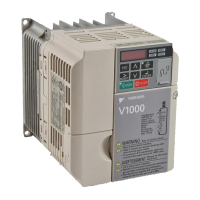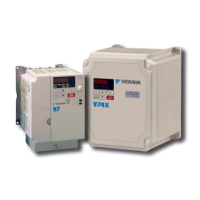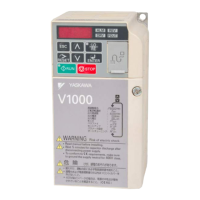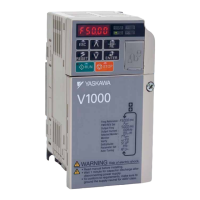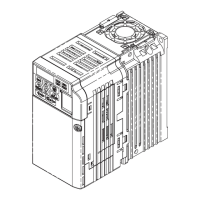Rotational Auto-Tuning for V/f Control
• Motor rotates during Auto-Tuning.
• Sets parameters required for torque compensation, slip compensation, energy savings, and speed search.
• Available only when the drive is set for V/f Control.
• Required to perform Estimation-Type Speed Search when using V/f Control.
Rotational Auto-Tuning for Open Loop Vector Control
• Used only when in Open Loop Vector Control.
• Perform only with the motor uncoupled from the load for applications requiring high performance over a wide speed range.
• Disconnect the load before Auto-Tuning the drive and motor. Performing Rotational Auto-Tuning with the load connected will set motor parameters
incorrectly, and also be dangerous because irregular motor rotation will occur.
• It is possible to perform Rotational Auto-Tuning with a connected load if the load is less than 30% of the rated load.
• Ensure a motor-mounted brake is fully released.
• Connected machinery should not produce enough power to rotate the motor.
Stationary Auto-Tuning for Terminal Resistance Only
• If the motor cable lead length has been significantly modified after Auto-Tuning has already been performed, perform Stationary Auto-Tuning with
the new cables.
• Perform when using motor cables longer than 50 m with V/f Control.
WARNING! Electrical Shock Hazard. When executing stationary Auto-Tuning for line-to-line resistance only, the motor does not rotate, however, power is applied. Do not touch
the motor until Auto-Tuning is completed. Failure to comply may result in injury from electrical shock.
Note: When auto-tuning a motor that is used on an application in conjunction with a brake, take special precaution to ensure the brake stays applied.
n
Auto-Tuning Fault Codes
Calculation of abnormal measurements or pressing
STOP
before completion will interrupt Auto-Tuning.
Refer to Auto-Tuning Errors on page 228 for more information.
A B
A – Normal Auto-Tuning Display B – Auto-Tuning Interrupted
Figure 4.29 Auto-Tuning Interruption Display
n
Performing Auto-Tuning
The following example illustrates how to perform Rotational Auto-Tuning.
Note: The following example is shown with the drive in Open Loop Vector Control (A1-02 = 2).
Selecting the Type of Auto-Tuning
Step Display/Result
1. Turn on the power to the drive. The initial display appears.
2.
Press the key until the Auto-Tuning screen appears.
3.
Press to begin setting parameters.
4.
Press to display the value for T1-01.
5.
Press to select the digit to edit.
6.
Press and set the drive to perform Rotational Auto-Tuning (00).
7.
Save the setting by pressing .
8. The display automatically returns to the screen shown in Step 3.
9.
Press the key until back at the Top Screen.
Enter Data from the Motor Nameplate
After selecting the type of Auto-Tuning, enter the required data from the motor nameplate.
Note: These instructions continue from Step 7 in Selecting the Type of Auto-Tuning.
Step Display/Result
1.
Press to access the motor output power parameter T1-02.
2.
Press to view the default setting.
4.7 Test Run
YASKAWA ELECTRIC SIEP C710606 18A YASKAWA AC Drive – V1000 Technical Manual (Preliminary)
93
4
Start-Up Programming
& Operation

